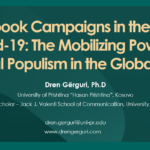Disinformation and misinformation, a by-product of journalists’ negligence to verify information
Verification of information has become necessary for everyone nowadays. If you do not verify the information you receive, then you leave open the possibility of being deceived by any manipulation. Therefore, it is essential that today, in the information we receive, especially on online media and social media, to have a question mark on their authenticity until the moment we verify and eliminate that question mark. This is a necessary step for all social media users, but such an action is also necessary for citizens who are informed by traditional media, or by online media/portals. In the case of portals, radios or televisions, citizens should verify the news by searching for it in several sources and paying attention to the sources on which the news is built.
Disinformation can be even more alarming when it is done by journalists, which happens in Kosovo, and other countries as well. Journalists in their work are the only ones who have the duty to keep the society well informed, this also means verifying any information they receive and publish in the media. If the journalist publishes unverified information in public, then he risks contributing to the contamination of the information environment in society. Unfortunately, we have such cases in our country as well. They are not in large numbers, but as much as they are, they should be criticized and denounced loudly, not for the fact that they should not be repeated and to save citizens from disinformation, but the publication of unverified information harms the profession of journalist and his image in society.
The case of misinformation about the great artist, Mirush Kabashi, is one of the examples that prove the lack of care and laziness of some journalists, who without taking the effort to take the first step in the work of a journalist, which is the verification of information, have published misinformation about the death of actor Kabashi. This misinformation had aroused reaction from the public who had believed it to be true. With this example we can draw two important conclusions. First, non-compliance with professional journalism standards and rushing to publish information without verifying it continue to undermine the mission of journalism. Second, it is related to society, its unpreparedness in relation to media content and the lack of critical judgment of information, whatever its nature.
The effect of a misinformation like this about the alleged separation from life of the artist Mirush Kabashi, or a misinformation/disinformation about another important personality of social, political, cultural, artistic life, etc., can provoke different reactions in society and affect well-being it can cause revolts and disturbances of public order, it can even affect the course of a political or social process. Hence, this social phenomenon only reveals the need for media literacy and highlights the necessity that, some of the skills of the century, which, among others, are: understanding the media, analyzing media content, and use of the media, to reach as soon as possible in all parts of society. If the current situation persists, then we will continue to have a society that is generally easy to manipulate as a society that generally lacks critical judgment. In order to remove the disinformation by the media and, at least for the narrowing of the suitable ground for their spread, a focused social and professional reaction to such phenomena is needed.
To conclude, in the case of the artist Mirush Kabashi, the citizens had believed the misinformation, although the news had no supporting source. Exactly this issue is raised in the model of three basic questions, which is built for citizens, but in today’s media environment, it also applies to journalists, who also often source of information have a post on social media, or receive it a news from another media and they do not verify it, but only convey it further to their audience. This also damages the reputation of the journalist, media and journalism, which, anyway, is under the target of the policy that compares the media with ‘fake news’, that it does not do journalism to inform society, but on the contrary, disinforming and misinforming. So journalists, before reporting, must go through at least two of the Model’s three questions, namely, who is the source of the information and which official sources it relies on.










